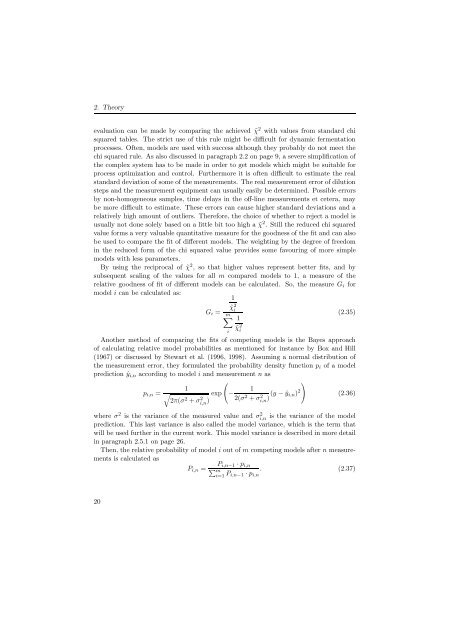Corynebacterium glutamicum - JUWEL - Forschungszentrum Jülich
Corynebacterium glutamicum - JUWEL - Forschungszentrum Jülich
Corynebacterium glutamicum - JUWEL - Forschungszentrum Jülich
You also want an ePaper? Increase the reach of your titles
YUMPU automatically turns print PDFs into web optimized ePapers that Google loves.
2. Theory<br />
evaluation can be made by comparing the achieved ˜χ 2 with values from standard chi<br />
squared tables. The strict use of this rule might be difficult for dynamic fermentation<br />
processes. Often, models are used with success although they probably do not meet the<br />
chi squared rule. As also discussed in paragraph 2.2 on page 9, a severe simplification of<br />
the complex system has to be made in order to get models which might be suitable for<br />
process optimization and control. Furthermore it is often difficult to estimate the real<br />
standard deviation of some of the measurements. The real measurement error of dilution<br />
steps and the measurement equipment can usually easily be determined. Possible errors<br />
by non-homogeneous samples, time delays in the off-line measurements et cetera, may<br />
be more difficult to estimate. These errors can cause higher standard deviations and a<br />
relatively high amount of outliers. Therefore, the choice of whether to reject a model is<br />
usually not done solely based on a little bit too high a ˜χ 2 . Still the reduced chi squared<br />
value forms a very valuable quantitative measure for the goodness of the fit and can also<br />
be used to compare the fit of different models. The weighting by the degree of freedom<br />
in the reduced form of the chi squared value provides some favouring of more simple<br />
models with less parameters.<br />
By using the reciprocal of ˜χ 2 , so that higher values represent better fits, and by<br />
subsequent scaling of the values for all m compared models to 1, a measure of the<br />
relative goodness of fit of different models can be calculated. So, the measure Gi for<br />
model i can be calculated as:<br />
Gi =<br />
1<br />
˜χ 2 i<br />
m�<br />
i<br />
1<br />
˜χ 2 i<br />
(2.35)<br />
Another method of comparing the fits of competing models is the Bayes approach<br />
of calculating relative model probabilities as mentioned for instance by Box and Hill<br />
(1967) or discussed by Stewart et al. (1996, 1998). Assuming a normal distribution of<br />
the measurement error, they formulated the probability density function pi of a model<br />
prediction ˆyi,n according to model i and measurement n as<br />
�<br />
�<br />
pi,n =<br />
1<br />
�<br />
2π(σ 2 + σ 2 i,n )<br />
exp<br />
−<br />
1<br />
2(σ2 + σ2 2<br />
− ˆyi,n)<br />
i,n )(y<br />
(2.36)<br />
where σ2 is the variance of the measured value and σ2 i,n is the variance of the model<br />
prediction. This last variance is also called the model variance, which is the term that<br />
will be used further in the current work. This model variance is described in more detail<br />
in paragraph 2.5.1 on page 26.<br />
Then, the relative probability of model i out of m competing models after n measurements<br />
is calculated as<br />
Pi,n−1 · pi,n<br />
Pi,n = �m i=1 Pi,n−1<br />
. (2.37)<br />
· pi,n<br />
20

















